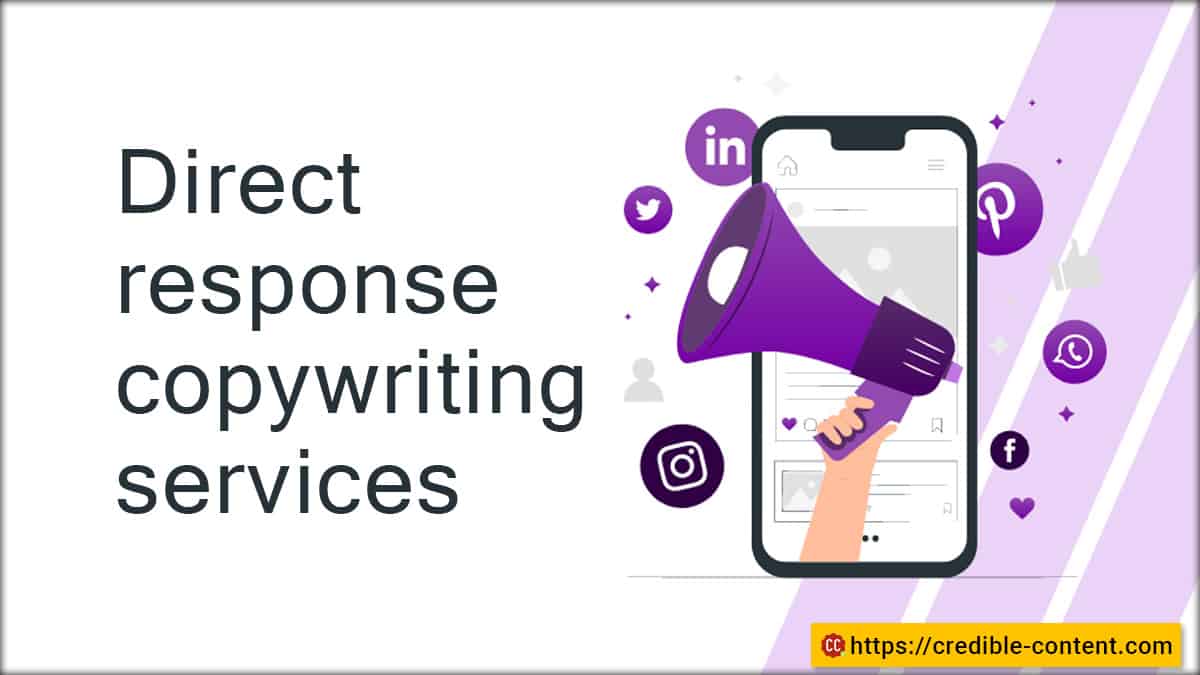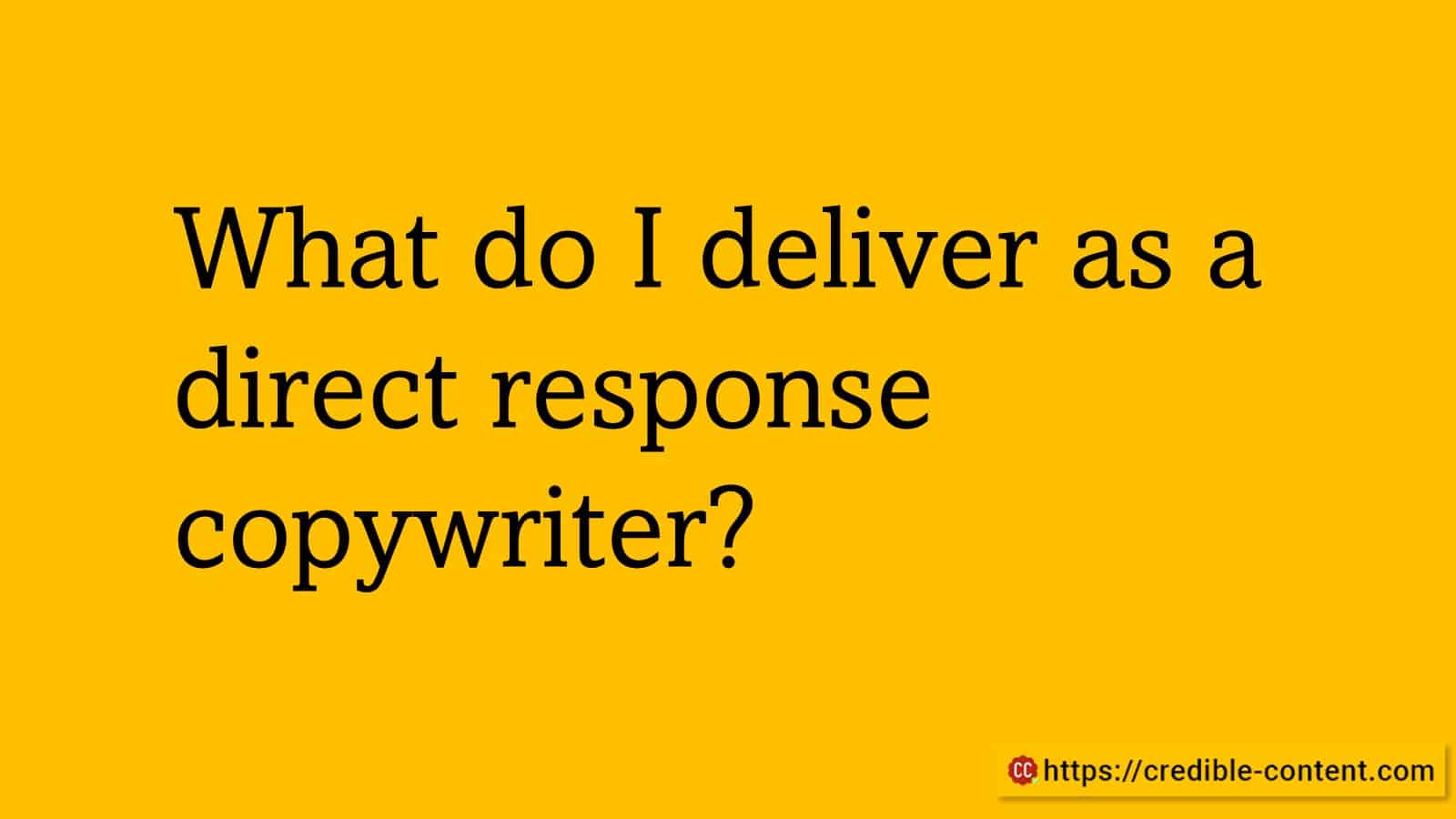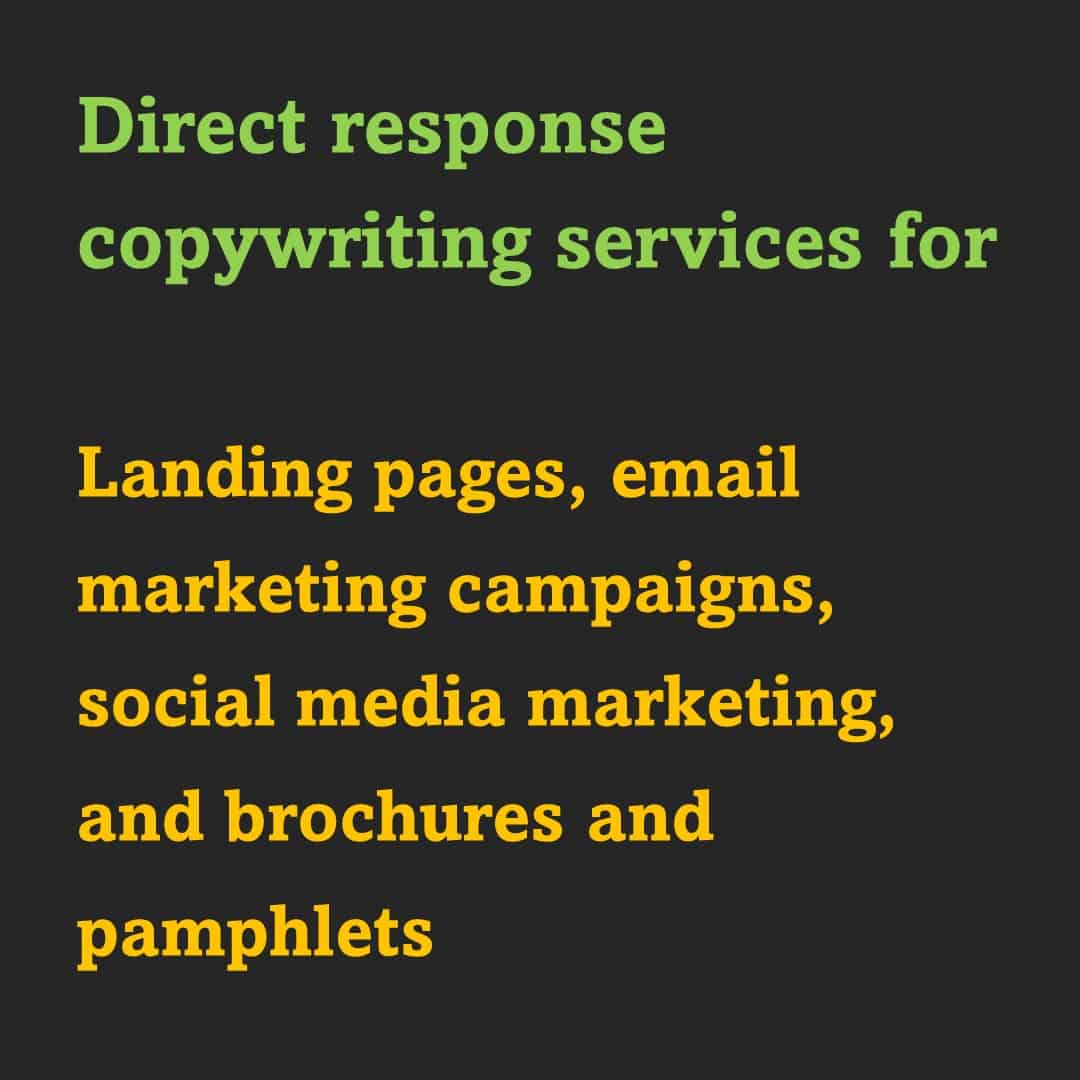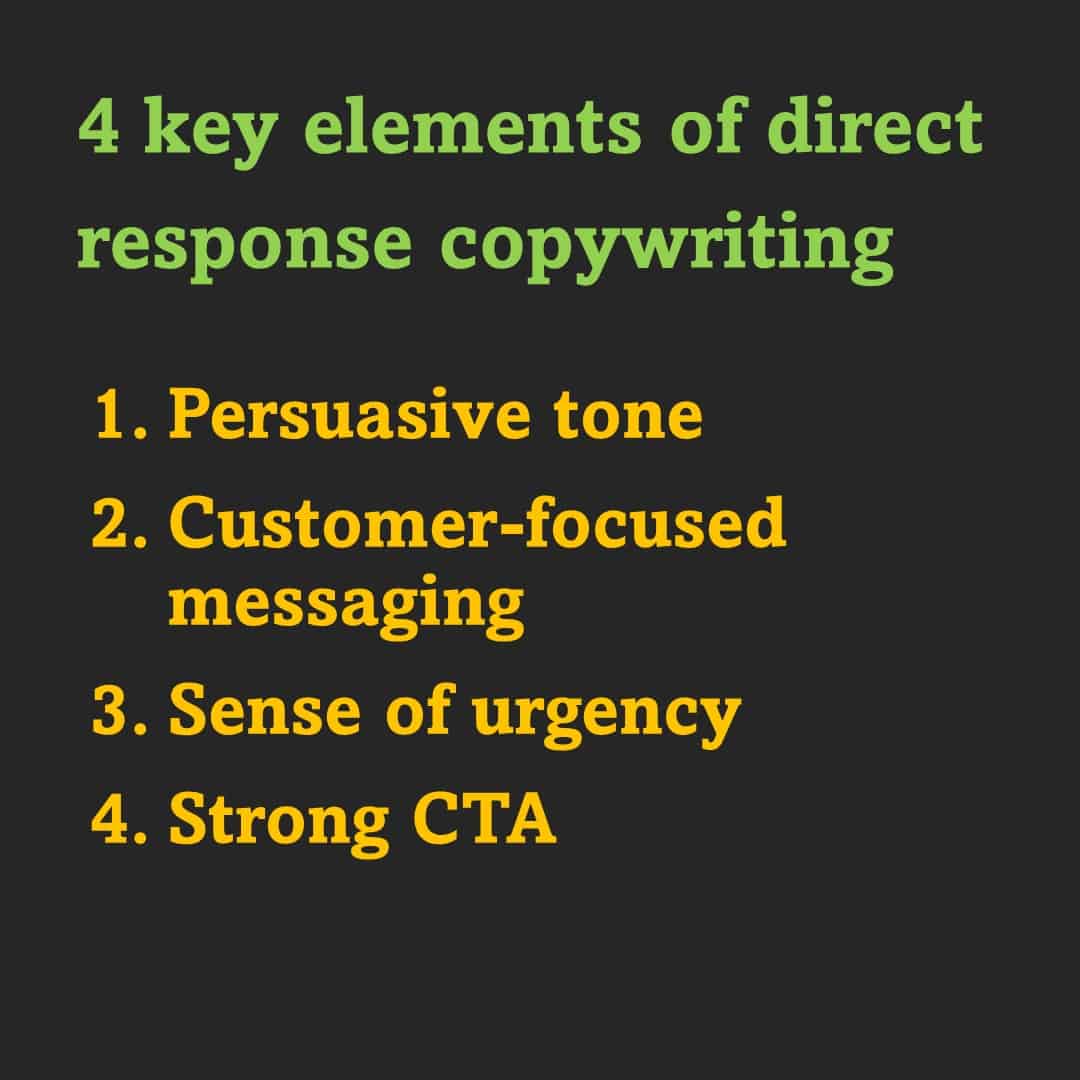
I can help you improve your response rate and generate more revenue.
So far, I have helped more than 55 companies with my direct response copywriting services increase their profits and grow beyond their goals.
Table of contents
- What do I deliver as your preferred direct response copywriter?
- Why do you need a direct response copywriter?
- What makes direct response copywriting compelling and effective?
- 4 key elements of direct response copywriting
- Outstanding features of direct response copywriting
- Differences between direct response copywriting and normal copywriting
- My direct response copywriting services
- As a direct response copywriter, which industries can write for?
- How direct response copywriting improves conversion rate
- Is there something called indirect response copywriting? What’s the difference?
As a business oriented direct response copywriter, I fully understand that ultimately, what matters is how much revenue you generate, and this is where I effectively provide my copywriting services.
On different websites you may come across expressions like, “I have helped my clients collectively generate $ 500 million so far.”
No, I cannot make such a claim because most of the clients never share their financial details with me. That’s fine with me. It has never even occurred to me to ask.
Then how do I know that my direct response copywriting works?
I receive praises from them. They keep coming back to me. They keep recommending my services to their colleagues and friends. Most of my work these days comes from my existing clients’ recommendations.
What do I deliver as your preferred direct response copywriter?

As a business owner, you obviously need results.
To get the best result out of direct response copywriting you need to clearly define what you want to achieve. Once you have decided that, the copy is written around that idea.
Over the years, after having worked with more than 800 clients, I have concluded that knowing what you want to achieve – your call to action – is very important.
With my direct response copywriting services, I can help you achieve the following:
- Improve your CTR.
- Improve your email open rate.
- Prolong retention after people have heard from you.
- Improve your search engine rankings (by raising the overall quality of your content).
- Provoke instantaneous response to your marketing message.
- Improve social media engagement.
- Get better conversion from your landing page.
- Make your website content more informative.
- Acquire more users for your mobile app.
Why do you need a direct response copywriter?
Here is why:
Want people to act immediately after reading your email copy?
Want people to submit the contact form on your landing page right there right now?
Through direct response copywriting, you seek reaction immediately from your target audience.
You use direct response copywriting to make people
- Contact you for work.
- Download a document (e-book, case study, white paper).
- Make a reservation (for a webinar or an online presentation).
- Buy your product.
- Book an appointment.
- Follow you on social media.
- Subscribe to your newsletter updates
- Reach out to you.
The key here is “immediate reaction”. When you want to elicit immediate reaction, you need a direct response copywriter to write your copy.

You can use my direct response copywriting services for
- Email marketing
- Landing pages
- Social media marketing
- Blogging
- Brochures and pamphlets
Blogging? Yes, in blogging too you can use copywriting to elicit immediate response from your readers.
What makes direct response copywriting compelling and effective?
This form of copywriting has the following components:
- A compelling headline or the subject line.
- The proof that you understand the consumer pain points.
- A solution your consumers can easily understand.
- Testimonials and validation.
- A call to action.
When writing a direct response landing page or email, it is very important that you are purposeful, intent driven, and you communicate compellingly.
You make a promise in the beginning that you’re going to solve a pressing problem. Then you draw an emotional picture of how your offer is going to change the life of the customer or client who is reading your copy.
Does it make sense to buy your product or service? Justify with logic.
Emotions draw attention to your marketing message, but logic makes people buy from you.
One of the biggest challenges in direct response copywriting is that you need to keep the readers hooked to your writing. Keep them reading. The moment they stop reading, they will grow disinterested, and you will lose your sale.
How to make your writing interesting?
Ask the right questions. Keep them curious. Make appropriate statements. Highlight segments that must draw attention. Learn how to create a rhythm of short and long sentences. Tell an engaging story.
4 key elements of direct response copywriting

What makes your copywriting effective to an extent that people respond immediately? Here are a few things to take care of:
Persuasive tone
Through your writing, you convince the reader to take an action or believe in an idea. For this, you use an authoritative voice, your present facts and figures, and you use emotional triggers to provoke fear of missing, and other such strong emotions.
Customer-focused messaging
Every customer is looking for WIIFM – what’s in it for me.
You need to communicate this factor in clear language, as early as possible.
What is the value you are delivering? How does the reader of your copy stand to gain by performing the action you want him or her to perform.
Also, make sure that the language is friendly, easy to read, and easy to understand.
Sense of urgency
You want people to act as fast as possible to your CTA. Otherwise, they either get distracted, or disinterested. How do you do that? How do you raise the level of urgency?
Offer them something that they really need or want.
Write as if the offer is limited and they will lose the chance of buying if they don’t buy right now. Set a deadline. Create scarcity.
Incite the fear of missing out – research has shown that people are twice as wary of losing then they are excited about gaining something.
You can also use Power words such as Free, Now, Hurry, Today only, Buy instantly, Don’t miss out, and such.
Write a strong call to action
It is your CTA that makes people act. But it should be clear, and action driven.
Avoid using CTA like, “Buy now”, or “Click here”, and such. Make the benefit clear when you are writing your CTA.
Some good CTA’s are
- Save 30% now
- Reserve your seat
- Start improving your rankings now
- Begin your health journey
- Become a better you
- Avail the discount
That is, use stronger, action words with your CTA.
Outstanding features of direct response copywriting
Direct response copywriting is a powerful tool for businesses of all sizes to generate leads, sales, and conversions. It involves crafting compelling messages that motivate readers to take a specific action, such as visiting a website, making a purchase, or signing up for a newsletter.
Here are some outstanding features of direct response copywriting:
Clarity and conciseness
- Focuses on a single, clear message. What do you want the reader to do? Make it crystal clear.
- Uses short, easy-to-understand sentences and words. No one wants to read a convoluted sales pitch.
- Avoids jargon and technical terms. Not everyone knows what you’re talking about.
- Gets to the point quickly. Don’t waste the reader’s time.
Benefit-driven
- Highlights the benefits of your product or service. What’s in it for the reader?
- Quantifies the benefits whenever possible. Use numbers to make your claims more believable. Improve conversion rate.
- Focuses on the reader’s needs and desires. What are their pain points? How can you help them?
- Uses strong verbs and action words. Tell the reader what to do.
Credibility and trust
- Backs up claims with evidence. Use testimonials, case studies, and data to build trust. Better conversion rate.
- Uses a conversational tone. Talk to the reader like a friend, not a stranger.
- Avoids hype and exaggeration. Be honest and transparent.
- Provides contact information. Make it easy for readers to reach you.
Urgency and scarcity
- Creates a sense of urgency. Make the reader feel like they need to act now.
- Offers limited-time deals or discounts. This increases the perceived value of your offer.
- Highlights the limited quantity of your product or service. This creates a sense of scarcity. Improve conversion rate.
- Uses phrases like “limited time” and “only a few left.” This adds to the urgency.
Emotional appeal
- Uses storytelling to connect with the reader on an emotional level. Share stories of people who have benefited from your product or service.
- Appeals to the reader’s hopes, fears, and desires. What motivates them?
- Uses vivid language and imagery to paint a picture in the reader’s mind. Make them feel like they can already experience the benefits of your offer. Better conversion rate.
- Creates a sense of community or belonging. Make the reader feel like they’re part of something bigger.
Differences between direct response copywriting and normal copywriting
- Purpose: Normal copywriting aims to inform or entertain; direct response copywriting aims to elicit immediate action.
- Focus: Normal copywriting often builds brand awareness; direct response copywriting focuses on immediate sales.
- Call to Action: Direct response always includes a strong, clear call to action; normal copywriting may not. Improve conversion rate.
- Measurability: Direct response copywriting’s success is easily measurable; normal copywriting’s impact is less direct.
- Style: Direct response is usually more aggressive and sales-oriented; normal copywriting can be subtler.
- Audience Engagement: Direct response seeks immediate engagement; normal copywriting often aims for gradual engagement. Improve conversion rate.
- Length: Direct response copy is often longer to persuade thoroughly; normal copy can be shorter and to the point.
- Urgency: Direct response often creates a sense of urgency; normal copywriting is less urgent.
- Personalization: Direct response is highly targeted and personalized; normal copywriting is often more general. Better conversion rate.
- Testing: Direct response copywriting undergoes rigorous A/B testing; normal copywriting less so.
- Headlines: Direct response headlines are directly tied to actions; normal headlines may prioritize creativity or branding.
- Language: Direct response uses persuasive, action-driven language; normal copywriting may use varied tones.
- Follow-up: Direct response includes mechanisms for immediate follow-up; normal copywriting often lacks this.
- Offers: Direct response makes specific offers; normal copywriting may not make any offers. Better conversion rate.
- Guarantees: Direct response often includes guarantees; this is less common in normal copywriting.
- Emotional Appeal: Direct response leverages strong emotions for immediate action; normal copy employs a broader emotional spectrum.
- Benefits Over Features: Direct response emphasizes benefits more than features; normal copywriting balances both.
- Psychological Triggers: Direct response heavily uses psychological triggers; normal copywriting uses them more subtly.
- Customer Testimonials: Direct response often includes customer testimonials; normal copywriting less frequently. Better conversion rate.
- Medium Use: Direct response is common in emails, landing pages, and mailers; normal copywriting spans a broader range of media.
My direct response copywriting services

As an experienced copywriter I can help you improve the response rate of your email campaigns and landing pages. I have developed a process of approaching direct response copywriting to get you the maximum response from your prospective customers and clients. I don’t base my writing on trial and error.
Here is what I will do as your direct response copywriter:
Understand your product or service
To be able to become an advocate of your product or service, it is very important that I understand what the biggest reason people would buy from you?
What would compel them? What is so irresistible in your product or service?
Understand your market
What troubles your customers and clients and how your product or service can eliminate those troubles? What sort of competition you face? Why you are better than your competitors? Improve conversion rate.
Write compellingly and persuasively
One of the biggest objectives of direct response copywriting is to prompt people to act, and this can only be achieved if you communicate your message compellingly and persuasive enough. Better conversion rate.
Communicate a distinct personality
It is very important for your customers and clients to envision your personality when they are reading your copy. Otherwise, they won’t be able to relate and if they don’t relate, they won’t believe your message, and if they don’t believe, they won’t buy from you.
Write in a language that is easy to understand
I achieve that without dumbifying my writing. It is professional, yet simple. It is easier to read yet it makes an impact. It uses the right balance of emotions and logic.
As a direct response copywriter, which industries can I write for?
I have been doing copywriting work for different industries for more than 17 years now (this is 2022-end).
Although I’m more comfortable writing on technology, digital marketing, content marketing, and web design, I have also done direct response copywriting for the following industries:
- Real estate
- Healthcare
- Accounting and bookkeeping
- Background check
- Construction
- Business consulting
- Fintech
- Personal and business coaching
- Self-development
- Cloud computing
- Investment consulting
- Non-profit work
- Legal consulting
- Logistics
Am I an expert in all these industries? No I’m not. Then how do I do direct response copywriting for these industries? Improve conversion rate.
To be able to work as a professional direct response copywriter, although you need a certain level of understanding of the industry you are writing for, you don’t need to be an expert.
I will give you a small example:
Recently I was approached by someone to write an email for someone who works at a delivery station. I had no idea what a delivery station is. Then there are people called “dwell chasers” – I had no idea what they did. The brief that she sent was riddled with jargon and I didn’t understand most of it. Better conversion rate.
Without getting rattled, I created a bulleted list of all the words and terms I didn’t understand.
She sent me all the explanations. I wrote the email. It was exactly what she was looking for.
Hence, whenever I don’t understand something, I seek information from the client – enough information to enable me to write the copy.
Wouldn’t it be easier for the client to seek someone who is an expert in the industry? Better conversion rate.
It isn’t normally easy to find an expert who is also a good writer. As a direct response copywriter, one should be able to write compellingly, and persuasively, and this can be achieved even when you’re not an industry expert.
It is very difficult to find a combination of an industry expert and also a good writer. An industry expert without good writing skills is obviously of no use. On the other hand, a good writer who can learn a few things about your industry and then convincingly write your marketing message, is much more useful to you.
How direct response copywriting improves conversion rate
- Highlights Urgency: Encourages quick action, improving conversion rates.
- Uses Emotional Triggers: Connects with readers’ emotions, leading to better conversion rates.
- Offers Clear Benefits: Makes benefits obvious, enhancing conversion rates.
- Creates Relatable Scenarios: Helps readers identify with the content, improving conversion rates.
- Uses Strong Call-to-Actions (CTAs): Directs readers effectively, boosting conversion rates.
- Incorporates Social Proof: Builds trust and credibility, aiding better conversion rates.
- Leverages Storytelling: Engages and persuades readers, improving conversion rates.
- Presents Solutions: Addresses readers’ problems, leading to better conversion rates.
- Employs Persuasive Language: Influences readers’ decisions, enhancing conversion rates.
- Focuses on Reader’s Needs: Personalizes the message, improving conversion rates.
- Demonstrates Product Value: Clarifies why the product is worth it, boosting conversion rates.
- Uses Testimonials and Reviews: Provides real-life proofs, leading to better conversion rates.
- Creates a Sense of Scarcity: Induces fear of missing out, improving conversion rates.
- Highlights Exclusivity: Makes the offer feel special, enhancing conversion rates.
- Provides Clear Instructions: Guides users on what to do next, boosting conversion rates.
- Utilizes Powerful Headlines: Grabs attention immediately, leading to better conversion rates.
- Answers Potential Objections: Addresses doubts upfront, improving conversion rates.
- Employs Consistent Messaging: Maintains brand voice throughout, enhancing conversion rates.
- Highlights Limited Time Offers: Creates urgency, boosting conversion rates.
- Uses Data and Statistics: Adds credibility to the message, leading to better conversion rates.
- Incorporates Visual Elements: Enhances the appeal of the copy, improving conversion rates.
- Optimizes for Readability: Ensures the copy is easy to read, enhancing conversion rates.
- Tailors Content to Audience Segments: Personalizes experiences, boosting conversion rates.
- Tests and Optimizes Copy: Continuously improves copy for effectiveness, leading to better conversion rates.
- Aligns with the Sales Funnel: Matches copy to the buyer’s journey stage, improving conversion rates.
Is there something called indirect response copywriting? What’s the difference?
Just like there is direct response copywriting, there is also indirect response copywriting. You already know the meaning of direct response copywriting? What is indirect response copywriting?
You don’t always want to elicit immediate response. Immediate response comes from just 10-15% of your content. Most of the response is delayed – you want to keep your audience engaged so that it becomes more receptive to your direct response messages. Improve conversion rate.
Direct response copywriting doesn’t work in isolation. You can’t just send an email to somebody’s inbox and then expect that person to respond favorably. There are many factors that play together, and one of the biggest factors is the fact that you have been engaging that person for a long time.
You achieve this through indirect response copywriting. Frankly, I don’t think there is such a term as “indirect response copywriting”, but copywriting done to keep your audience engaged for a long time can be termed as such.
Some examples are informative articles, blog posts, newsletter issues, and social media posts.
Looking for an experienced copywriter who can help you with your direct response copywriting project? Contact me today.


